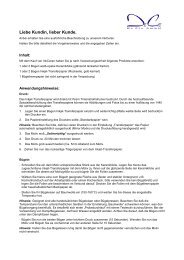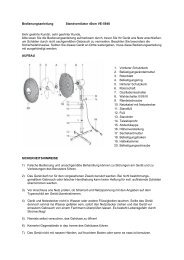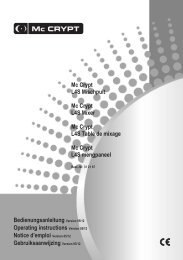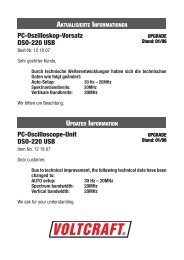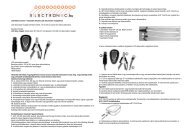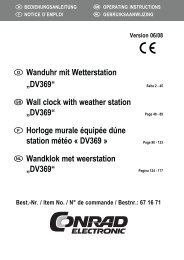Bleiakku-Ladestation CT-1500Pb Lead Accumulator ... - Electronic.hu
Bleiakku-Ladestation CT-1500Pb Lead Accumulator ... - Electronic.hu
Bleiakku-Ladestation CT-1500Pb Lead Accumulator ... - Electronic.hu
Erfolgreiche ePaper selbst erstellen
Machen Sie aus Ihren PDF Publikationen ein blätterbares Flipbook mit unserer einzigartigen Google optimierten e-Paper Software.
Deux oeillets sont disposés sur le dos de l’appareil pour le fixer à un mur au moyen<br />
de crochets.<br />
Raccordement<br />
Reliez la prise réseau de la station de chargement à une prise réseau appropriée et<br />
mettez-la en marche.<br />
Lorsqu’aucun accumulateur n’est branché, l’indicateur de fonctionnement apparaît<br />
avec affichage de la température ambiante.<br />
«CHARGE- TERMINAL»<br />
« 22° C »<br />
Placez la sonde de température à proximité de l’accumulateur. Eviter les rayons<br />
directs du soleil sur la sonde de température et sur les accumulateurs.<br />
<br />
En cas de chargement d’une batterie montée sur un véhicule, respecter<br />
l’ordre de raccordement suivant :<br />
Interrompre la liaison entre la batterie et la carrosserie du véhicule.<br />
Raccorder d’abord la borne de batterie (la plupart du temps le pôle<br />
positif ), qui n’était pas reliée au châssis du véhicule. Une fois éloignée<br />
des conduites d’essence, la borne de batterie (la plupart du temps le<br />
pôle négatif) qui était reliée au châssis est alors raccordée. Reliez la<br />
fiche réseau de la station de chargement à une prise réseau appropriée<br />
et mettez l’appareil en marche.<br />
Après l’opération de charge, débranchez l’appareil de chargement du réseau :<br />
Débranchez d’abord le câble négatif puis le câble positif. Rétablir la liaison entre la<br />
batterie et la carrosserie.<br />
Lorsqu’il n’y a pas d’accumulateur branché à l’appareil, il est possible de régler la<br />
langue (allemand et anglais) et le contraste de l’affichage. Confirmez votre choix<br />
avec la touche OK.<br />
«LANGUE »<br />
«1. Allemand »<br />
«2. Anglais »<br />
«CONTRASTE »<br />
«1. FORT »<br />
«2. NORMAL »<br />
«3. FAIBLE »<br />
Etablissez alors le contact aux pôles de l’accumulateur en respectant la polarité.<br />
Reliez la borne polaire rouge au pôle positif de l’accumulateur, et la borne polaire<br />
noire au pôle négatif de l’accumulateur.<br />
En cas de court-circuit des deux bornes, le message suivant apparaît « -> court-circuit<br />
! ».<br />
36<br />
The discharge current is always automatically adjusted to the capacity of the accumulator.<br />
The final discharge voltage can be selected.<br />
For standard lead accumulators, the final discharge voltage can be set from 1.80 to<br />
2.10V in steps of 10mV; a value of 2.00V is recommended.<br />
For lead gel and lead fleece accumulators, the final discharge voltage can be set<br />
from 1.70 to 2.00V in steps of 10mV; a value of 1.90V is recommended.<br />
„DISCHARGE VOLTAGE”<br />
„ 2.00V ”<br />
In the WINTER programme it is necessary to determine the pause period to be maintained<br />
between the cycles. It can be set from 3 to 30 days; a pause of 7 days is recommended.<br />
„ENTER PAUSE ”<br />
„ 7 DAYS PAUSE ”<br />
Now the programme starts.<br />
CAUTION!<br />
If any of the parameters has not been entered correctly, the lead accumulator is to be<br />
disconnected immediately and then connected anew. All parameters are to be<br />
entered again!<br />
During the start, the flashing arrow indicates whether the corresponding accumulator<br />
is charged or discharged at the moment. The CHA, CYC and ALV programmes start<br />
with a charging process, whereas the CHK and WIN programmes start with a discharging<br />
process.<br />
All available data of the accumulator are displayed.<br />
There are two display types provided. These two display types are selected via the<br />
UP and DOWN keys. With the OK button pressed, the two displays are shown alternately.<br />
„CHA S>C= 17.4mAh”<br />
„St12V D= 0.0mAh”<br />
„23° C >U= 12.109V”<br />
„00:01 I= 0.200A”<br />
During this process, the first line indicates the charge programme (e.g. CHA for<br />
CHARGE), an accumulator symbol for the charge status of the accumulator (in this<br />
case indicated by an „S“ for symbol) and the charging capacity. If a charge process<br />
is currently running, an arrow flashes before „C“.<br />
The second line contains the type of the accumulator (St for standard accumulators,<br />
GV for gel or fleece lead accumulators), the nominal accumulator voltage selected (6V<br />
for an accumulator with 3 cells, 12V for 6 cells) and the discharging capacity. If a discharge<br />
process is currently running, an arrow flashes before „D“.<br />
25



